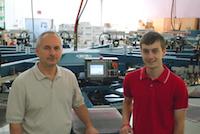By Geoff Baxter
In most screen printing operations, mesh is stretched to a specific tension and then glued or stapled to static frames. Self-tensioning frames, on the other hand, have built-in tensioning mechanisms. Not only can the mesh be stretched on the frame without a separate screen stretcher, the mesh can be re-tensioned when necessary.
Another advantage of self-tensioning frames is they're constructed of steel or aluminum. Unlike wood frames, those made of metal aren't susceptible to changes in atmospheric conditions. Wood frames expand and contract with changes in temperature and humidity. Wood's flexibility also leaves it prone to deflect under normal printing tensions. This can reduce tension even more, and loss of tension means loss of control over the screen printing process. However, even though static metal screen frames are far less susceptible to distortion, they don't address the tendency of synthetic fabrics to soften or relax.
Synthetic fabrics go through a process known as cold flow. Molecules are normally bunched together when fabric is not under tension, but they re-align under stress, whether it's the stress applied during initial screen stretching or the stress applied by the squeegee pressing against the mesh.
Visualize a tow chain. At rest, its links are bunched together. However, when the chain is hooked up for towing, the links are re-aligned in the direction they're pulled. Just as the links in a tow chain will cease to move when they have reached the point of maximum extension, the molecules of the fabric will also stretch (flow) only to a given point. This is known as maximum elongation. At this point, the fabric is far more stable. Unlike a tow chain, however, mesh has a tendency to relax (stretch) after initial tensioning.
Since self-tensioning frames can re-tension mesh after initial stretching, they're able to compensate for the cold flow process. Eventually, in a process commonly referred to as work hardening, the mesh will near the point of maximum elongation. Screen tension plays a far more critical roll in the printing process than many realize, and once the fabric is work-hardened, many printing problems diminish—or simply disappear.
Here are just a few of the critical areas affect by screen tension:
Registration: The most obvious result of proper screen tension is more accurate registration. The expansion and contraction of wooden frames—and the relaxation of the fabric on static frames of wood or metal—produce constantly floating images. It's difficult, if not impossible, to register a moving target.
Consistency: The ability to stabilize screen tension at a consistent level eliminates one of the factors that can cause print variance, especially on repeat runs.
Increased Opacity on Darks: High fabric tension makes it easier to print thick, high-opacity plastisol. Loose mesh deflects under pressure, and that forces the operator to apply even more pressure. Tightly-stretched mesh, on the other hand, exhibits only minor deflection, allowing ink to be deposited onto the garment with minimal squeegee pressure. This not only reduces the effort required but also deposits the ink only on the surface of the garment, producing a high-opacity print. Otherwise, an unnecessarily large amount of ink will be driven through the garment by the high level of force needed to overcome an improperly tensioned screen. In addition to reduced wear and tear on the fabric, properly tensioned screens can dramatically reduce ink consumption—and the associated cost.
Increased Four—Color Process Consistency: Anyone can print a great looking four-color process print. The trick is to maintain consistency throughout the print run. The first shirt always looks good, but image degradation will usually be noticeable 50-100 shirts into the print run, and the 1000th shirt may barely resemble the first. These changes are the result of the diminished registration and uncontrollable dot gain that result from loss of screen tension.
I was sold on self-tensioning frames several years ago when I saw, two four-color process prints from the same run: the first shirt of the run and the 100,000th. Both were made on the same set of screens, but I could find no noticeable difference.
Decreased Build-up: Since less pressure is needed to force the ink through the mesh, less ink should be picked up by the backside of other screens. This greatly reduces ink buildup and image smearing.
Increased Productivity: One of the most significant benefits of self-tensioning frames is increased productivity. First, high-tension screens achieve proper ink deposit with far less effort. Second, high-tension screens have a much faster peel rate with less off-contact. That, in turn, allows print-stroke speeds to be dramatically increased with little or no impact on image quality. Third, less time needs to be devoted to clearing away ink buildup. Fourth, on long print runs, screens can be re-tensioned instead of replaced.
Increased use of self-tensioning screens has encouraged more manufacturers to enter the business. The additional competition has helped drive down prices and introduce more refined designs. Unfortunately, this does not mean all manufacturers are offering technologically-advanced, high-quality self-tensioning screens. A poorly-designed, poorly-manufactured self-tensioning frame is worse than a less expensive static frame, so make sure you spend the time necessary to properly research and substantiate—or refute—the claims of the people who sell those products.
If you haven't done so already, consider converting to self-tensioning frames. It's one of the most important steps you can take to keep your business profitable.
© 2004 Geoffrey Baxter no unauthorized duplication without written consent of the author.

About the Author
- Email Address geoff.baxter@mrprint.com
- Phone 630-487-0065
Geoff Baxter previously served as President and co-founder of Atlantic Screen Supply, Inc. His 30-year industry career includes management positions with Logo-7, Harlequin Nature Graphics, Advance Process Supply Co., and Precision Screen Machines. He has also written numerous articles for trade publications and lectured at many industry events.
Geoff can be reached at geoff.baxter@mrprint.com.



